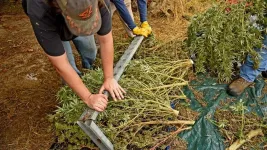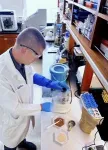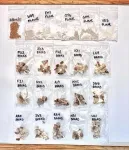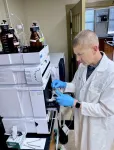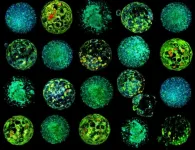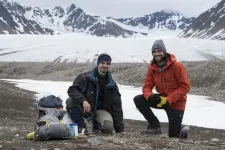(Press-News.org) A new North Carolina State University study examining the availability and content of commercial stock farmworker photos – images often used in health- and safety-education materials for farmworkers – shows a dearth of useful depictions of the people who work on farms and the tasks they perform. The study’s recommendations could lead to more relevant education materials that gain more attention and engagement from farmworkers
“I was really interested in how farmworkers were represented in stock-photo libraries,” said Catherine LePrevost, agromedicine extension specialist and associate extension professor in NC State’s Department of Applied Ecology. “A lot of my work is with farmworkers and creating interventions, including health-education interventions. Right now, we're doing a lot of work with digital inclusion with farmworkers.
“My suspicion was that we would find a lot of stock photos that didn't represent the people who are actually working in agriculture.”
The study confirmed that suspicion.
The researchers – including a team from East Carolina University – scoured commercial stock-image libraries online to find photos of farmworkers. They found 127 photos of “farmworkers” or “women farmworkers”; two of the five photo libraries queried had no relevant images at the time of the search.
Only 66 of the 104 photos that included a person showed the person’s face; 23 photos did not include a person at all. Most of the people who were shown were young or middle-aged adults who tended to be light-skinned.
About three-quarters of the photos showed manual or hand labor rather than mechanized work.
“Not only is the work not mechanized, but it hardly represents the type of agriculture we have in North Carolina and across the country,” LePrevost said. “It’s challenging to think about how to develop educational materials for the future of agriculture in terms of technology and mechanization. Having stock photos that don't align with that reality doesn’t help matters.”
Only 11 of 89 photos that showed farmworkers working also depicted some type of hazard. And only 16 of the 89 photos showed farmworkers wearing personal protection equipment – gloves and hats were the most likely items worn. One photo even showed a child performing agricultural work.
“As educators. we need diverse images of personal protective equipment so that we can create tailored safety messages depending on the conditions faced by farmworkers, whether that’s extreme heat, chemicals or other hazards,” LePrevost said.
The researchers say that resources appear to be an obstacle to the creation of useful materials.
“If people don't have a lot of resources, if they haven't budgeted to have different photos taken, then they may end up relying on conventional stock photos, even when those photos were originally taken for a much different purpose. That's what ends up in our educational materials,” LePrevost said.
Overall, the researchers say that the lack of useful materials means there’s a missed opportunity to educate farmworkers.
“The danger here is that people don't perceive materials as relevant, and without that relevance they are less likely to use protective behaviors that we're trying to encourage through North Carolina Extension programs,” LePrevost said.
“I'm really interested now in thinking about how we can engage agricultural communities and then develop materials that are tailored and relevant to have a positive impact on safety behaviors.
“We know that this has been a problem, but hopefully documenting it can help people build resources into their budgets to develop more relevant images,” LePrevost added. “This study is a call to action for people in agricultural safety and health to think about how we can work together and support each other – especially farmworkers – to develop more relevant images.”
The study appears in the Journal of Agromedicine. The research was supported by the National Library of Medicine of the National Institutes of Health under award number G08LM013198. The content is solely the responsibility of the authors and does not necessarily represent the official views of the National Institutes of Health.
- kulikowski -
Note to editors: The abstract of the paper follows.
“Assessing Stock Photos for Farmworker Health and Safety Education Materials”
Authors: Catherine E. LePrevost, Emery L. Harwell and Michelle A. Jewell, North Carolina State University; Abdul G. Zahra, Jose A. Robles Arvizu and Joseph G. L. Lee, East Carolina University
Published: June 21, 2024 in Journal of Agromedicine
DOI: 10.1080/1059924X.2024.2368728
Abstract:
Objectives: The aim of this study was to analyze how farmworkers are represented in stock photos available in commercial libraries for use in agricultural health and safety education materials.
Methods: We searched for images in five commercial stock photo libraries using the terms “farmworkers” and “women farmworkers” in April 2022. We used quantitative content analysis. We coded each image for containing a visible face, age, gender, skin color, work activity, mechanization, presence of hazards, technology use, and protective equipment/clothing after establishing inter-coder reliability. We used descriptive statistics to characterize the available stock photos.
Results: We identified stock photos (n = 127) in three databases (Adobe Stock Images, Canva, and Getty Images). Two databases (Microsoft Office Image Library and Pixabay) had no relevant images at the time of the search. Only half of the photos analyzed contained a face. Light skin colors and young or middle-aged adults were more common. A majority of farming activities represented in photos were manual tasks (e.g. harvesting) with few depictions of equipment, hazards, and protective equipment/clothing.
Conclusions: Health and safety professionals tasked with developing materials for education in agricultural settings face a severe lack of imagery pertinent to the realistic conditions of farmworkers in the United States. In the databases we reviewed, photos displaying human faces, photos showing a range of skin colors and ages, and photos displaying an array of different farm hazards are likely not sufficient for material development. Health and safety professionals may benefit from sharing photos from their own work with other professionals and allocating resources for professional photo shoots in their material development projects.
END
URBANA, Ill. — Domesticated animals play a prominent role in our society, with two-thirds of American families enjoying the companionship of pets and many others relying on animal products for their nutritional needs. But the process of domestication remains a bit of a mystery. Convincing wild animals they are safe enough to coexist and mate in enclosures and in close proximity to humans and other animals is no small feat. What does it take behaviorally and genetically for that to happen?
For the most part, the animals we’ve domesticated have been docile for so long that ...
The Simons Foundation’s Flatiron Institute has launched a new initiative focused on advancing the science of catalysis. The Initiative for Computational Catalysis (ICC), which began operations on July 1, will harness computational techniques to study and design substances called catalysts that speed up chemical reactions. Such substances promise to be instrumental in clean energy generation and in reducing greenhouse gas emissions from industrial processes.
“These are big questions that are hard to address from the very first step of the ...
WASHINGTON – U.S. Naval Research Laboratory (NRL) Remote Sensing Division intern, Amaris McCarver, along with a team of astronomers, discovered the first millisecond pulsar in the stellar cluster Glimpse-CO1 and recently published findings in the Astrophysical Journal.
Pulsars are natural laboratories for studying the behavior of matter under extreme gravitational and magnetic fields - conditions difficult or impossible to replicate on Earth.
They also function as natural timekeepers. Precise timing of the observed pulses from an array of pulsars offers a means to ...
Chicago (July 1, 2024) — What does whole wheat have that refined flour lacks? A new study reveals key differences in nutrient content along with exactly where nutrients are lost — and sometimes gained — along the journey from farm to table.
While previous studies have assessed the nutrients contained in various crops or in food products, the new study is among the first to bridge the two by tracing how processing and baking influence nutrient composition at each step.
Researchers report that levels of major minerals were cut by nearly three-quarters ...
A new technology developed by the "Bioengineering in Reproductive Health" team at the Institute for Bioengineering of Catalonia (IBEC) is able to visualise the metabolism of embryos obtained through in vitro fertilisation in order to decide which are most likely to implant correctly in the uterus and reaching full-term. It is a more accurate and reliable technique than traditional methods.
The revolutionary method, called METAPHOR", generates 3D images that reveal the colours present in the embryo in a completely non-invasive way. Certain naturally fluorescent compounds in the embryo's metabolism are also key to processes such as cellular respiration ...
Melting Arctic glaciers are in rapid recession, and microscopic organisms colonise the newly exposed landscapes. Dr. James Bradley, Honorary Reader in Arctic Biogeochemistry in the School of Biological and Behavioural Sciences at Queen Mary University of London, and his team, have revealed that yeasts play an important role in soil formation in the Arctic after glaciers have melted away.
Roughly 10% of Earth’s land surface is covered by glacial ice. However, glaciers are retreating ever further and ever faster because of global warming. As they do, ...
EMBARGOED UNTIL JULY 1, 2024 AT 3:00 PM U.S. EASTERN TIME
According to a new study published in the Proceedings of the National Academy of Sciences, extensive land areas have been left sitting idle after tropical forests were cleared in Indonesia, a country renowned for its biodiverse rainforests and carbon-rich peatlands. Since 1990, the country has lost 25% of its old-growth forest, and while over one-quarter (7.8 million hectares) of Indonesia’s deforested lands have been converted to palm oil plantations since ...
University of Cincinnati researchers have pioneered an animal model that sheds light on the role an understudied organ in the brain has in repairing damage caused by stroke.
The research, published July 5 in the Proceedings of the National Academy of Sciences, sought to learn more about how the adult brain generates new neurons to repair damaged tissue.
The research team focused on the choroid plexus, a small organ within brain ventricles that produces the brain’s cerebrospinal fluid (CSF). CSF circulates throughout the brain, carrying signaling molecules and other factors thought to be important for maintaining brain function. However, prior to this study, little ...
Smoking continues to rank as the foremost preventable cause of premature death. In a paper published this week in the Proceedings of the National Academy of Science (PNAS), Harvard researchers report findings that evoking feelings of gratitude in people who smoke helps reduce their urge to smoke, and increases their likelihood of enrollment in a smoking cessation program. They note that these findings could inform newer approaches to public health messaging campaigns that aim to reduce so-called “appetitive” risk behaviors like smoking, drinking, and drug use.
The research team built on the Appraisal Tendency Framework, a theoretical model of emotiona and decision making, ...
The COVID-19 pandemic had an unprecedented effect on college students’ mental health: symptoms like anxiety and major depression in young adults ages 18-25 increased significantly compared to before the pandemic.
A new study from researchers at the University of North Carolina at Chapel Hill looks at a possible contributing factor to the worsening trends in mental health: social media.
We know that college students and adolescents are using social media more. Last May, the US Surgeon General issued an advisory on social media and youth mental ...
